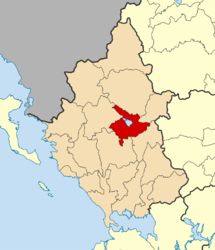Ioannina, Greece
|
Ioannina Ιωάννινα |
||
|---|---|---|

|
||
|
||
| Coordinates: 39°40′N 20°51′E / 39.667°N 20.850°ECoordinates: 39°40′N 20°51′E / 39.667°N 20.850°E | ||
| Country | Greece | |
| Administrative region | Epirus | |
| Regional unit | Ioannina | |
| Government | ||
| • Mayor | Thomas Begas | |
| Area | ||
| • Municipality | 403.32 km2 (155.72 sq mi) | |
| • Municipal unit | 47.44 km2 (18.32 sq mi) | |
| Elevation | 480 m (1,570 ft) | |
| Population (2011) | ||
| • Municipality | 112,486 | |
| • Municipality density | 280/km2 (720/sq mi) | |
| • Municipal unit | 80,371 | |
| • Municipal unit density | 1,700/km2 (4,400/sq mi) | |
| Community | ||
| • Population | 65,574 (2011) | |
| • Area (km2) | 17.355 | |
| Time zone | EET (UTC+2) | |
| • Summer (DST) | EEST (UTC+3) | |
| Postal code | 45x xx | |
| Area code(s) | 26510 | |
| Vehicle registration | ΙΝ | |
| Website | www.ioannina.gr | |
Ioannina (Greek: Ιωάννινα, Greek pronunciation: [io̞ˈɐ.ni.nɐ]), often called Yannena (Γιάννενα, Greek pronunciation: [ˈʝɐ.ne̞.nɐ]) within Greece, is the capital and largest city of Epirus, an administrative region in north-western Greece. Its population is 112,486, according to 2011 census. It lies at an elevation of approximately 500 metres (1,640 feet) above sea level, on the western shore of lake Pamvotis (Παμβώτις). It is the capital of Ioannina regional unit and the region of Epirus. Ioannina is located 450 km (280 mi) northwest of Athens, 290 kilometres (180 miles) southwest of Thessaloniki and 80 km (50 miles) east of the port of Igoumenitsa in the Ionian Sea.
The city's foundation has traditionally been ascribed to the Byzantine Emperor Justinian in the 6th century AD, but modern archaeological research has uncovered evidence of Hellenistic origins. Ioannina flourished in the late Byzantine period (13th–15th centuries). Part of the Despotate of Epirus following the Fourth Crusade, many wealthy Byzantine families fled there following the sack of Constantinople, and the city experienced great prosperity and considerable autonomy, despite the political turmoils. It surrendered to the Ottomans in 1430. Between 1430 and 1868 the city was the administrative center of the Pashalik of Yanina. In the period between the 18th and 19th centuries, the city was a major center of the modern Greek Enlightenment. Ioannina joined Greece in 1913 following the Balkan Wars.
...
Wikipedia



